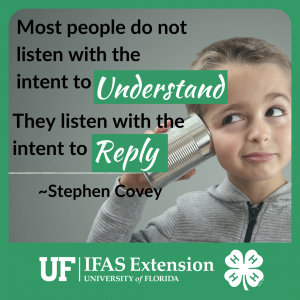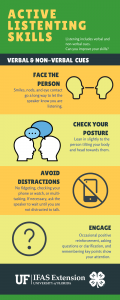 Listening is a skill that can be learned, and is just as important (if not more so) than speaking. However, when it comes to teaching communication skills in 4-H, we have a tendency to focus on the speaking or writing part more than the listening part. So…we are kicking off our series on communication by focusing on this very important skill! This blog post will cover, how active listening can benefit adults and youth, tips for active listening, and some activities you can do with your 4-Hers to help them begin building and practicing solid listening skills.
Listening is a skill that can be learned, and is just as important (if not more so) than speaking. However, when it comes to teaching communication skills in 4-H, we have a tendency to focus on the speaking or writing part more than the listening part. So…we are kicking off our series on communication by focusing on this very important skill! This blog post will cover, how active listening can benefit adults and youth, tips for active listening, and some activities you can do with your 4-Hers to help them begin building and practicing solid listening skills.
Why focus on listening?
Listening and hearing are not the same- listening involves processing what you have heard, and for many people (including myself) it takes practice! A better description of listening well is active listening. Active listening requires the listener to fully concentrate, understand, respond, and, then….remember what is being said. Being a good listener also requires being mindful of what you are hearing. Mindfulness is paying attention in a particular way, on purpose, in the present moment – and non-judgmentally. The goal of mindful listening is to silence the internal noise of your own thoughts, so that you can hear the whole message, and so that the speaker feels understood.
Benefits of Active Listening
There are several benefits to being a good listener.
- Prevent and resolve conflict
- Build trust
- Helps you learn
- Most importantly, good listening skills foster a sense of belonging, which is the most basic measure of a quality youth development program.
So how can we become better listeners? Here are a few tips:
• Just listen. Be attentive when you are listening. Do not let other thoughts, like what you are going to say in response, distract you.
• Express interest. Use eye contact, posture, and facial expressions to let people know you are interested in what they have to say and that you are ready to listen. Listening is a form of non-verbal communication, which we will delve more deeply into next week during our Virtual Volunteer Leadership Webinar.
• Reduce distractions. If possible, refrain from doing other tasks while you are listening so that you can focus on hearing what is being said.
• Listen for emotions. Emotions can be expressed through tone, but also through body language- what does the tone and body language of the person tell you? Are they expressing excitement, frustration, joy or sadness? Be very careful not to judge what the other person is feeling.
• Repeat it back. Once the person has finished talking, summarize what you heard and ask them to clarify if necessary.
• Don’t be afraid of silence. A silent moment allows the speaker and the listener to process what has been said through words, tone and body language.
How can we teach listening skills to youth?
Here are a few activities you can do virtually or in person with youth of all ages (and adults too). For instructions, click the link or read the instructions below the table. For more ideas, and strategies for non-verbal communication, sign up for our webinar series every third Thursday of the month at 6PM central, 7PM eastern.
| Activity | Cloverbuds
(5-7 yrs.) |
Juniors
(8-10 yrs.) |
Intermediates
(11-13 yrs.) |
Seniors
(14-18 yrs.) |
Adults |
| Simon Says | X | X | |||
| Paper Tearing | X | X | X | X | |
| Listening Inventory | X | X | |||
| Shh…Just Listen | X | X | X | ||
| What’s your Problem? | X | X |
Paper-Tearing Exercise
1.) Pass out a sheet of paper to everyone and tell them the following: “We’re going to play a game that will show some important things about communication. Pick up a sheet of paper and hold it in front of you. Now, close your eyes and follow the directions I will give you—and no peeking! You cannot ask questions.”
2.) Give the following directions, carrying them out yourself with your own sheet of paper and pausing after each instruction to give the group time to comply:
• Fold your sheet of paper in half.
• Tear off the upper right-hand corner.
• Fold it in half again and tear off the upper left-hand corner.
• Fold it in half again and tear off the lower right-hand corner.
3.) After the tearing is complete, say something like, “Now open your eyes, and let’s see what you have. If I did a good job of communicating and you did a good job of listening, all of our sheets should look the same!”
4.) Hold your sheet up for them to see and discuss outcome.
• It is highly unlikely any sheet will match yours exactly.
• How are our papers different?
• Why don’t our papers match?
• How could a different communication method have helped us with this
activity?
Source: Strieter, L. (2008). Communications: Overview of Communications.
Shhhh. Just Listen…
1.) Work in pairs – Select one person to be the listener and one person to be the speaker.
2.) Challenge: The listener has to get the speaker to continue talking for five minutes, but can only make three statements during the time period. The speaker will talk about a situation that was a joyous occasion (ex. might be an award, a special event, a new job, etc.).
3.) Switch roles after five minutes.
4.) Return to whole group for reflection and discussion. The discussion that follows concentrates on how:
- The speaker felt when the person just listened and did not exchange information
- The nonverbal signals encouraged the speaker
- Uncomfortable the silence was
- It felt to just listen without having the pressure to contribute
- The speaker felt having the freedom to say whatever they felt
Source: Listening & Communication Exercises by Work Smart Blog, Posted online by Leslie Orr
http://blog.trainerswarehouse.com/communication -exercises
What’s Your Problem?
1.) Work in Pairs: One person is the listener and the other is the speaker.
2.) Role play: The listener practices active listening and tries to diffuse the tense situation. The speaker is upset because of [fill in any scenario].
3.) Discussion: The best way to diffuse a tense situation is to use active listening – it is important that the person knows you hear what they are saying. It is also important not to make any promises at that stage of the exchange. Acknowledge the person’s frustration and let them vent. Then, move on to problem solving – get the person to help in solving the problem and then work on solving it together.
Source: Listening & Communication Exercises by Work Smart Blog, Posted online by Tom Lord http://blog.trainerswarehouse.com/communication-exercises
- Meet our Summer Intern- Andy Franklin! - June 13, 2025
- Blue Ribbon Baked Goods - September 23, 2024
- Blue Ribbon Photos and Posters - September 21, 2024

